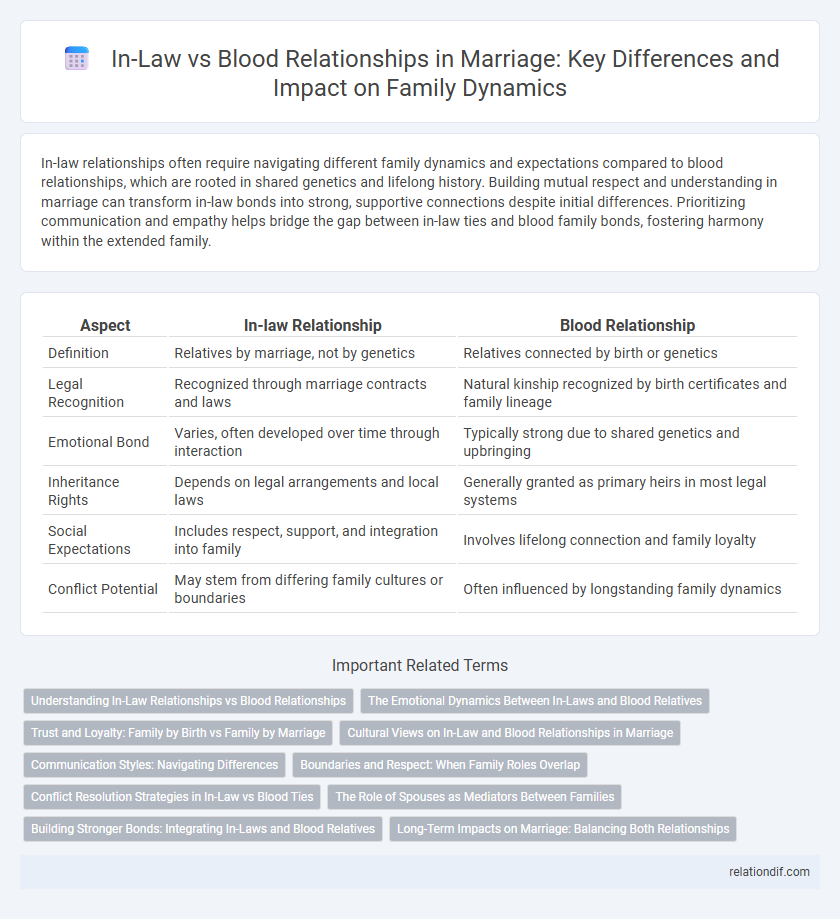In-law relationships often require navigating different family dynamics and expectations compared to blood relationships, which are rooted in shared genetics and lifelong history. Building mutual respect and understanding in marriage can transform in-law bonds into strong, supportive connections despite initial differences. Prioritizing communication and empathy helps bridge the gap between in-law ties and blood family bonds, fostering harmony within the extended family.
Table of Comparison
| Aspect | In-law Relationship | Blood Relationship |
|---|---|---|
| Definition | Relatives by marriage, not by genetics | Relatives connected by birth or genetics |
| Legal Recognition | Recognized through marriage contracts and laws | Natural kinship recognized by birth certificates and family lineage |
| Emotional Bond | Varies, often developed over time through interaction | Typically strong due to shared genetics and upbringing |
| Inheritance Rights | Depends on legal arrangements and local laws | Generally granted as primary heirs in most legal systems |
| Social Expectations | Includes respect, support, and integration into family | Involves lifelong connection and family loyalty |
| Conflict Potential | May stem from differing family cultures or boundaries | Often influenced by longstanding family dynamics |
Understanding In-Law Relationships vs Blood Relationships
In-law relationships are formed through marriage and create legal and social bonds between families, unlike blood relationships which are based on genetic connections. Understanding the dynamics of in-law relationships involves recognizing the blend of cultural expectations, communication styles, and evolving family roles. Navigating these connections requires empathy and respect to balance obligations and emotional attachments inherent in family structures.
The Emotional Dynamics Between In-Laws and Blood Relatives
Emotional dynamics between in-laws and blood relatives often differ due to varying degrees of biological connection and familial history, impacting expectations and interactions. Blood relatives typically share a deep-rooted bond formed through shared genetics and lifelong experiences, fostering inherent loyalty and understanding. In comparison, in-law relationships require active emotional investment, negotiation of boundaries, and the building of trust to bridge the gap between familial origins and marital ties.
Trust and Loyalty: Family by Birth vs Family by Marriage
Trust and loyalty in blood relationships often stem from lifelong shared experiences and genetic bonds, fostering an inherent sense of obligation and emotional security. In-law relationships, while initially built on external ties, can develop deep trust and loyalty through intentional communication, mutual respect, and shared family values over time. Both family by birth and family by marriage play crucial roles in an individual's support system, with trust evolving based on commitment and consistent positive interactions rather than solely on biological connections.
Cultural Views on In-Law and Blood Relationships in Marriage
Cultural views on in-law and blood relationships in marriage vary significantly, with many societies placing strong emphasis on blood ties as foundational to family identity and loyalty. In-law relationships are often shaped by cultural norms governing respect, roles, and integration into the extended family, influencing marital harmony and social cohesion. Understanding these cultural perspectives helps navigate expectations and strengthens the bond between spouses and their respective families.
Communication Styles: Navigating Differences
In-law relationships often require deliberate adjustments in communication styles compared to blood relationships, as expectations and emotional dynamics differ. Understanding and respecting these variations fosters clearer dialogue and reduces misunderstandings. Developing empathetic listening and setting boundaries enhance harmony between in-laws and blood relatives, promoting stronger family cohesion.
Boundaries and Respect: When Family Roles Overlap
In-law relationships require clear boundaries and mutual respect to navigate the complexities that arise when family roles overlap with blood relations. Establishing respectful communication and understanding individual limits helps maintain harmony without compromising the unique bond of blood relatives. Prioritizing empathy and setting expectations prevents conflicts and fosters a supportive family environment.
Conflict Resolution Strategies in In-Law vs Blood Ties
Conflict resolution in in-law relationships often requires heightened sensitivity to boundaries and respect for differing family dynamics compared to blood ties, where deeper emotional history may intensify disputes. Effective strategies include establishing clear communication channels, practicing empathy to bridge cultural or value gaps, and setting mutually agreed-upon limits to reduce tension. Mediating conflicts with neutral third parties or counselors can further enhance understanding and facilitate harmonious interactions between in-laws and blood relatives.
The Role of Spouses as Mediators Between Families
Spouses act as crucial mediators between in-law and blood relationships, balancing loyalty and fostering understanding to maintain family harmony. Their role involves navigating cultural and emotional differences, ensuring communication bridges gaps between both families. Effective mediation by spouses reduces conflicts and strengthens interfamily bonds, contributing to long-term marital stability.
Building Stronger Bonds: Integrating In-Laws and Blood Relatives
Building stronger bonds between in-laws and blood relatives requires open communication and mutual respect to bridge differing family cultures and expectations. Shared family traditions, inclusive celebrations, and joint problem-solving foster a sense of unity and belonging among all members. Prioritizing empathy and active listening helps transform potential conflicts into opportunities for deeper connections within the extended family network.
Long-Term Impacts on Marriage: Balancing Both Relationships
In-law relationships and blood relationships both exert significant long-term impacts on marriage stability and satisfaction. Navigating conflicts and fostering mutual respect between spouses' families enhances emotional support systems, reducing stress and promoting marital resilience. Prioritizing open communication and boundary-setting facilitates a balanced integration of in-law dynamics with inherent blood ties, strengthening couples' long-term commitment.
In-law Relationship vs Blood Relationship Infographic

 relationdif.com
relationdif.com